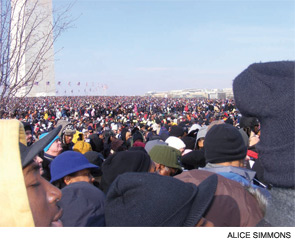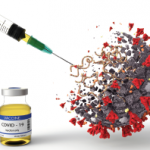
To appreciate the inauguration of Barack Obama, it had to be witnessed from the ground. The attempts to show the National Mall from a satellite failed miserably. The technology to scope out events from space is certainly nifty, but it diminished, not enhanced, the joyous pilgrimage that had assembled. From hundreds of miles above earth, the crowds looked like a swarm of ants or puddles of muddy brown sludge.
Everything about the inauguration was thrilling, even if Itzhak and Yo-Yo had to bow-sync “Air and Simple Gifts” in the frigid air. The thrill came from both a desire for and an anticipation of change. Regrettably, America is on the financial ropes and we will suffer a knockout blow unless we act responsibility, get beyond childish ways, and enact real change. Business as usual will no longer work and we have to prepare for a brave new world that will be unsettling and frightening because of the magnitude of change we need.
Healthcare is part of that change. If someone from the podium on the Capitol steps had said, “If you want change in healthcare, please raise your hand,” I would bet that every hand would shoot up and create an upward draft to set the flags fluttering wildly.
Alas, change in the healthcare will not be simple because our system is broken and the solutions for change are as numerous as were the people on the Mall. Although we had a magical display of unity on January 20, Americans are individualists to the core. There are still Republicans and Democrats, red states and blue states, and red people and blue people. In the wonderful poetry of his inauguration benediction, Reverend Joseph Lowery enumerated the colors in the American tapestry. A tapestry is great, but the colors are still brightly there.

Dreams of Change
In the future, as we decide about change in healthcare, we will have to make important distinctions: change we can believe in, change we can agree upon, and change that we can afford.
More often than not, the desire for change is personal, and I know the change I want. Near the top of my wish list for healthcare change is research funding. Research is the engine of medical progress and it drives improvement in patient care. I want more money for the National Institutes of Health, Department of Veterans Affairs, and Centers for Disease Control and Prevention—so much money that you see the stacks of greenbacks from the satellite cyclops in the sky. I want the research coffers to overflow and get scientists back to work.
Furthermore, from my perspective, I would like to see investment in infrastructure go to universities, hospitals, and pharmacy plans. Highway cloverleaves are fine but I am not sure that they are the best investment, and bridges to nowhere are precisely that. Computers to organize medical records seem a better outlay of taxpayer money than another layer of asphalt on a road that is only slightly rutted. I can take a few bumps on the way to the hospital if I know that anyone who needs expensive medicines will get them.
The wishes of other physicians are no doubt different than mine, and patients will have their own agendas and priorities. If there were ever a Healthcare March on Washington, I would suspect that there would be myriad placards and signs waved aloft by marchers as they trudged their way to the Capitol. The diversity of messages would be dizzying and would testify to the extraordinary needs throughout the healthcare system.
Times are tough and everyone (and I mean everyone) is going to go to Washington wanting change (which means money) to help his or her sector of the economy.
Change We Can Afford
What are the most pressing needs in healthcare where we want change? I know that the sky is not the limit. Deficits are ballooning, billion-dollar bailouts are burgeoning daily, and serious choices have to be made. Any change we want we have to afford. I hope that the American people—patients and providers both—can find common ground to present to Washington a clear message for remaking the healthcare system.
While wrenching decisions remain for the future, it is still good to savor the uplifting spirit of Inauguration Day. In a conference room of my hospital, a big-screen TV was set up to allow staff to watch the inauguration as their work on the wards allowed. The feeling of solidarity was high as doctors, nurses, policemen, and janitors sat together, reverent and transfixed in the flickering glow of the screen.
Other people in the hospital felt drawn to D.C. and had to make personal witness to the inauguration. My secretary, Alice Simmons—an unsung hero who struggles to make our clinic work—journeyed in a large bus caravan that drove through the night on the interstate, passing the Petersburg battlefield on the way through Virginia. This was a reverse Freedom Ride as the buses went from south and north, but there was no fear of attack as in days gone by, just excitement about a great happening.
I asked my secretary to show me pictures and, a week after the inauguration, she brought a CD to the clinic for viewing. On the computer in the office, we watched as her group with their Obama regalia boarded buses in the dark, disembarked at a parking lot at RFK Stadium, and then walked together to the Mall. In the photos, everyone was bundled up but they all looked ready to pop out of their coats from sheer exhilaration.
The best pictures showed the scene on the Mall. Unlike the satellite photos that blurred people beyond recognition, Simmons’ pictures magnified the people and captured, in the bright sun of Washington, the radiance on their faces. These people were not ants. These people were pieces of confetti, decorating the grass in the midst of momentous celebration.
I do not know what the future in healthcare will hold, but the expressions on those faces shouted change that we can believe in and change that we can agree upon.
And, to people of all generations, this is change we have to afford.
Dr. Pisetsky is physician editor of The Rheumatologist and professor of medicine and immunology at Duke University Medical Center in Durham, N.C.
